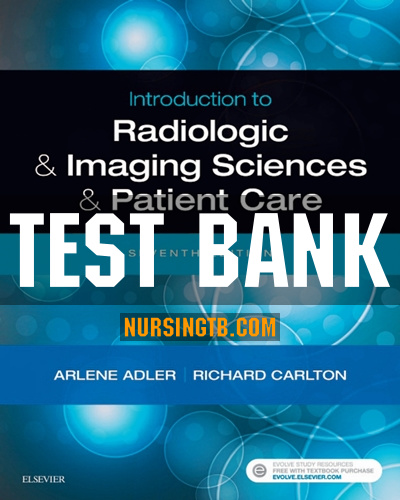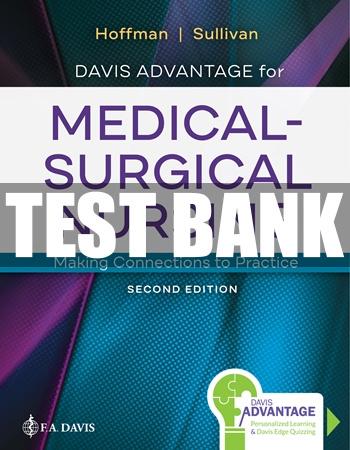Test Bank for Introduction to Radiologic and Imaging Sciences and Patient Care 7th Edition Adler
Chapter 01: Introduction to Imaging and Radiologic Sciences
MULTIPLE CHOICE
1. The use of X-rays to create a medical image on patients is referred to as
a. electrocardiography.
b. radiography.
c. sonography.
d. magnetic resonance imaging.
ANS: B
Radiography is the making of records, known as radiographs, of internal structures of the
body by the passage of X-rays or gamma rays through the body to act on, historically, especially
sensitized film or, most commonly, on a digital imaging plate or detector. In the diagnostic
radiography department, images are created using X-rays that pass through the body.
REF: p. 3
2. Particular care must be taken when using radiation for medical imaging. This is the result of
radiation’s ability to create in human tissue and possible biochemical changes.
a. ionizations
b. radio waves
c. sound waves
d. thermal changes
ANS: A
Some forms of electromagnetic energy, including X-rays, have the ability to ionize atoms in
matter. These ionizations have the ability to disrupt the composition of matter and are capable
of disrupting life processes. Special protection should be provided to prevent excessive
exposure to ionizing radiation.
REF: p. 3
3. In the diagnosis of patient disease states, physicians can select from an array of medical
diagnostic modalities. Some of these involve the use of ionizing energy to create a medical
image. If a physician is concerned about the use of ionizing radiation, he or she may choose to
order any of the following diagnostic modalities except
a. thermograms.
b. medical sonography.
c. radiography.
d. magnetic resonance imaging.
ANS: C
Radiography is the making of records, known as radiographs, of internal structures of the
body by passage of X-rays or gamma rays through the body to act on, historically, specially
sensitized film or, most commonly, on a digital imaging plate or detector. In the diagnostic
radiography department, images are created using X-rays that pass through the body (Fig.
1.2). Proper radiation protection is essential.
REF: p. 3
4. The Greek physician Hippocrates is regarded as the father of Western medicine. All of the
following choices represent his medical beliefs except the
a. use of high ethical standards of conduct.
b. important medical value of sorcery and witchcraft.
c. importance of closely monitoring a patient’s condition and recovery.
d. value of diet and exercise and allowing nature to take its course in recovery.
ANS: B
The Hippocratic Corpus is writings that they emphasize rational and natural explanations for
the treatment of disease and reject sorcery and magic. The Hippocratic Oath still governs the
ethical conduct of physicians today.
REF: p. 5
5. Throughout the history of medicine, remarkable achievements have been recorded. These
events have led to our current understanding of the human organism and disease. As this
research continues, much of it will most likely focus on
a. proper sanitation and public health.
b. immunology and the development of vaccines.
c. germ theory and infection.
d. human genes and genetic engineering.
ANS: D
Although the Human Genome Project is finished, analyses of the data will continue for many
years. The replacement of faulty genes through gene therapy offers promises of cures for a
variety of hereditary diseases and through gBen.Celtic engineering, important pharmaceuticals continue to be developed. Medical research will continue to focus on the genetic code in all
cells.
REF: p. 5 | p. 6
6. Wilhelm C. Roentgen’s discovery of “the X-ray” is regarded as one of medicine’s most
significant achievements. Although his discovery was accidental, his early research was so
Introduction to Radiologic and Imaging Sciences and Patient Care 7th Edition Adler Test Bank
thorough that no significant findings have been added to his original theories. This in itself is
a true tribute to the brilliance of Roentgen as a scientist. One of the most famous early images
he created was an X-ray image of his
a. colon.
b. laboratory assistant’s foot.
c. wife’s hand.
d. kidneys.
ANS: C
November 8, 1895, is believed by historians to be the day that Roentgen created the famous
image of the hand of his wife. Through his investigative methods, Roentgen identified the
properties of X-rays. His methods were so thorough that no significant additions have been
made to his work.
REF: p. 6



